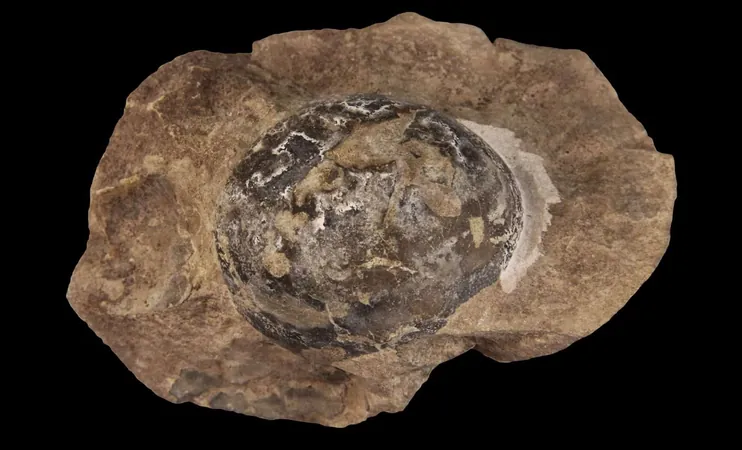
Giant Fossil Egg Discovered in Antarctica Shakes Up Prehistoric History!
2025-05-26
Author: Siti
Groundbreaking Discovery in Antarctica
Scientists are buzzing with excitement after the discovery of a colossal soft-shelled fossil egg in the frigid expanse of Antarctica. This enormous egg, dubbed Antarcticoolithus bradyi, dates back an astonishing 68 million years and is roughly the size of a football. It stands as the largest soft-shelled egg ever uncovered and the second-largest of any species known on our planet!
A Riddle from the Ancient Past
Unearthed during a Chilean expedition in 2011, this extraordinary fossil left researchers scratching their heads for years. Unlike the robust, hard-shelled eggs typically associated with dinosaurs, this egg boasts a soft, thin lining akin to the eggs of modern snakes and lizards. Measuring about 11 inches long and 8 inches wide, its crumpled, deflated appearance led to the amusing nickname, "The Thing," inspired by the iconic Antarctic horror film. Julia Clarke, a vertebrate paleontologist from the University of Texas at Austin, spearheaded the study that finally unveiled its enigmatic nature.
An Epic Clue: The Mosasaur Connection
The fossil was found close to the remains of Kaikaifilu hervei, a gigantic mosasaur that measured over 23 feet in length. These ancient reptiles were the rulers of the late Cretaceous oceans and are relatives of contemporary snakes and lizards. The egg's impressive size and its location alongside juvenile mosasaur and plesiosaur fossils hint that this area may have functioned as a nursery for marine reptiles. Lead researcher Lucas Legendre noted, "It's from an animal the size of a large dinosaur, but it is completely unlike a dinosaur egg." In an extensive study of 259 modern reptiles, the team concluded that the egg's parent was most likely a mosasaur, suggesting a previously unrecognized reproductive strategy among these ancient creatures.
Soft-Shelled Eggs: A Game Changer
One of the most striking revelations from this discovery is the challenge it presents to age-old theories about dinosaur reproduction. Soft-shelled eggs, like A. bradyi, are rarely preserved as fossils, resulting in their scarcity in the paleontological record. However, this find, along with similar discoveries, implies that soft-shelled eggs may have been far more typical among ancient reptiles than historians have assumed. Mark Norell, chair of paleontology at the American Museum of Natural History, remarked, "The assumption has always been that the ancestral dinosaur egg was hard-shelled. These findings prove otherwise." Interestingly, evidence suggests that the transition from soft to hard shells occurred independently multiple times across dinosaur lineages.
Revising Evolutionary Narratives
The impact of this discovery goes beyond the taxonomy of ancient reptiles, influencing our understanding of evolution itself. For years, scientists have leaned heavily on comparisons with modern birds and crocodiles to decode the biology of dinosaurs. However, the newfound fossil evidence paints a richer, more complicated picture of prehistoric life. Matteo Fabbri, a researcher at Yale and coauthor of the study, stated, "From an evolutionary perspective, this makes much more sense than previous hypotheses." This fresh insight emphasizes the necessity of broadening our scope when piecing together the ancient world.
Antarctica: A Portal to the Prehistoric World
As Antarctica continues to reveal its secrets locked in ice and stone, it provides us with a captivating glimpse into a world long gone, full of unexpected revelations that challenge our understanding of history.



 Brasil (PT)
Brasil (PT)
 Canada (EN)
Canada (EN)
 Chile (ES)
Chile (ES)
 Česko (CS)
Česko (CS)
 대한민국 (KO)
대한민국 (KO)
 España (ES)
España (ES)
 France (FR)
France (FR)
 Hong Kong (EN)
Hong Kong (EN)
 Italia (IT)
Italia (IT)
 日本 (JA)
日本 (JA)
 Magyarország (HU)
Magyarország (HU)
 Norge (NO)
Norge (NO)
 Polska (PL)
Polska (PL)
 Schweiz (DE)
Schweiz (DE)
 Singapore (EN)
Singapore (EN)
 Sverige (SV)
Sverige (SV)
 Suomi (FI)
Suomi (FI)
 Türkiye (TR)
Türkiye (TR)
 الإمارات العربية المتحدة (AR)
الإمارات العربية المتحدة (AR)